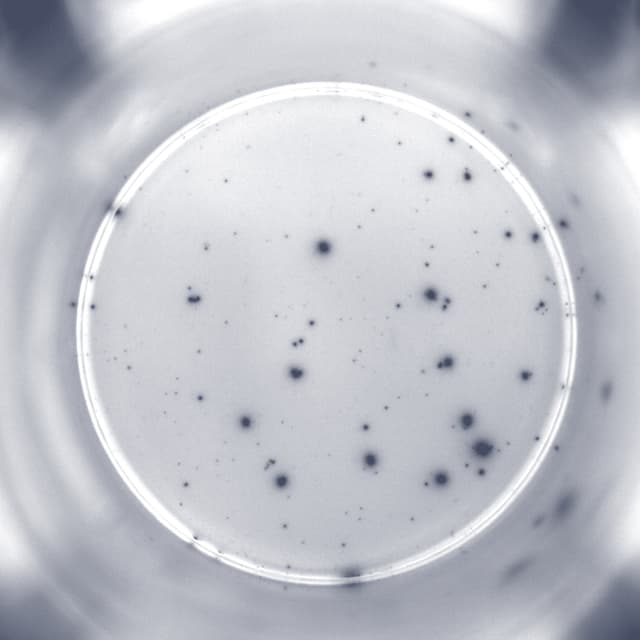
Immunoassays for infectious disease research
Published: October 28, 2024
Updated: November 18, 2025
18 minute read
Authored by: Jens Gertow
Immunoassays like ELISpot and FluoroSpot play pivotal roles in infectious disease research by allowing the detection of immune responses at a cellular level, helping scientists understand the immune mechanisms underlying various infections. Here, we explore the application of Mabtech immunoassays in research on major infectious diseases, including Tuberculosis (TB), SARS-CoV-2, Malaria, HIV, Mpox, Tick-Borne Encephalitis (TBE), Lyme disease, influenza, cytomegalovirus (CMV), Epstein-Barr virus (EBV), and BK virus.
The immune system’s ability to fight infectious agents largely depends on cellular immunity, particularly the action of T cells and their ability to secrete cytokines that modulate immune responses. Immunoassays like ELISpot and FluoroSpot, which quantify cytokine-secreting cells at the single-cell level, are particularly well-suited for studying immune responses against infectious pathogens. By capturing cytokines or other immune-related molecules released by individual cells, these immunoassays allow researchers to investigate pathogen-specific immune responses for diagnosis as well as vaccine development.
Tuberculosis (TB)
Tuberculosis, caused by Mycobacterium tuberculosis, remains one of the most significant infectious diseases globally. Research into TB immunity has benefited greatly from the use of ELISpot, especially in monitoring T cell responses. ELISpot assays, especially those targeting IFN-γ, are commonly used in both vaccine development and diagnosis.
For example, the IFN-γ ELISpot assay has been widely used in the detection of latent TB infection by measuring the release of IFN-γ in response to specific M. tuberculosis antigens such as ESAT-6 and CFP-10. As such, ELISpot in TB diagnosis is a form of Interferon-gamma Release Assay (IGRA). It’s important to note that IGRAs can also be ELISA-based.
Regardless of the basis of the IGRA, though, many healthcare providers have realized the advantage of IGRA compared to the classical tuberculin tests (TST) for diagnosis, as TST can produce false positive results in individuals who have received the Bacillus Calmette-Guérin (BCG) vaccine.
M. tuberculosis hide in lung granulomas
Up-and-coming antigens
Research is ongoing to make TB diagnostics even more sophisticated and accurate, using additional antigens as well as other biomarkers. Already today, ELISpot can be adapted to test multiple TB-specific antigens, enhancing diagnostic accuracy. For example, in our ELISpot Path kit (RUO), we include the antigen EspC in addition to the traditional ESAT-6 and CFP-10. This third antigen can come in handy for diagnostics if future non-BCG vaccines start incorporating ESAT-6 and/or CFP-10, which would make the present IGRAs unfit to distinguish vaccinated from infected subjects.
Peptide pools distinguish active TB from latent
Ongoing research on multi-antigen panels holds promise for more effective TB diagnosis in the future – including emerging knowledge of what T cell epitopes give responses in patients with active disease but not in subjects with latent infection.
In their effort to help design new diagnostics and vaccines for TB, Cecilia Lindestam Arlehamn and her co-workers at the La Jolla Institute for Immunology performed a proteome-wide screening of TB-derived peptides in TB patients, using an IFN-γ and IL-17A FluoroSpot assay and Mabtech IRIS FluoroSpot reader.
The comparison revealed that patients with active TB respond to different T cell epitopes than otherwise healthy but latently infected patients. With this information, the research group developed a peptide pool consisting of epitopes antigens exclusively recognized by patients with active TB, allowing the discrimination of participants with active disease from latent infections.
A peptide pool like this will be important for measuring correlates of protection in vaccine development, as well as a possible tool for novel diagnostic assays.
Dr. Cecilia Lindestam Arlehamn
Biomarkers other than IFN-γ
In addition to looking at expanded antigen panels, research is currently being done to identify other functional biomarkers for TB diagnosis. The cytokine IFN-γ is a great biomarker for general immune responses, but there may be additional detailed info to be gained by looking at alternative proteins.
Christopher Sundling and his team at Karolinska Institutet utilized Olink’s exploratory multiplex assay and identified a 12-protein plasma signature that was highly enriched in individuals with pulmonary and extrapulmonary TB and also associated with disease severity.
Dr. Christopher Sundling
Photo credit: Carolina Sousa Silva
Among the 12 proteins, four of the most differentially abundant were IFN-γ, IL-6, VEGF, and IP-10, and their findings were corroborated by several previous proteomic studies: IFN-γ levels increase during active TB; IL-6 has been associated with active and cavitary TB; VEGF promotes blood vessel formation and can be produced by macrophages in TB granulomas. Finally, IP-10 (Interferon-γ-inducible Protein 10) has the potential to be a more sensitive biomarker for diagnostics than IFN-γ, as the protein is induced downstream of IFN-γ, and the signal could theoretically be amplified.
To study for example IP-10 on a single cell level, a good tool is our ELISpot Plus: Human IP-10.
More recently, multiplex cytokine profiling by Folkesson et al. (2025) added an additional layer of resolution to the differentiation between active and latent TB, complementing Lindestam Arlehamn's findings above: While epitope-level differences already highlight distinct immune reactivity patterns, measuring IFN-γ, IL-2, and TNF-α in parallel using the Mabtech EYRA™ platform revealed distinct cytokine signatures between patient groups, further enhancing discrimination and informing diagnostic and vaccine development strategies.
Taken together, new peptide pools as well as novel biomarkers are of interest for improved TB diagnostics and vaccine development. The use of a multiplex tool like FluoroSpot or bead-based multiplex platforms gives an enriched view of the disease status and severity as well as help guide treatment and enhance TB control.
Want to learn more? Watch Cecilia Lindestam Arlehamn and Christopher Sundling present mentioned biomarkers and peptide pool in our TB webinar.
SARS-CoV-2
The COVID-19 pandemic, caused by SARS-CoV-2, prompted a rapid increase in research efforts focusing on immune responses to the virus.
ELISpot assays have been used extensively to evaluate T cell responses to SARS-CoV-2, providing crucial information about both natural infection and vaccine-induced immunity.
One study utilized FluoroSpot Path: SARS-CoV-2 (S1scan+SNMO) Human IFN-γ/IL-2 to detect T cells producing cytokines IFN-γ and IL-2 in response to SARS-CoV-2-specific antigens including spike (S), nucleocapsid (N), and membrane (M) proteins (Sherina et al., 2022). The results revealed that individuals who recover from COVID-19 often have robust T cell responses, which may play a critical role in long-term protection.
SARS-CoV-2 was the cause of COVID-19
In addition to T cell responses, humoral responses are of course important, and we’d like to emphasize that it’s not enough to merely study antibody titers. Even though antibody levels may decrease over time, memory B cells can persist, and to get a full view of the immunity of an individual, memory B cells are easily studied using B cell ELISpot or FluoroSpot. In fact, there are few other technologies that can detect memory B cell responses so directly. A research group at Karolinska Institutet used our ELISpot Path: SARS‑CoV‑2 (RBD) Human IgG (ALP) to learn that memory B cell responses indeed persisted despite waning antibody titers. Here is a summary of these SARS-CoV-2 papers associated with the story.
Already early on during the pandemic, we stressed the need to study T cells as well as memory B cells, and not stare blindly at antibody titers. This culminated with a webinar in November 2020 together with Assoc. Prof. Marcus Buggert from Karolinska Institutet, showcasing ELISpot and FluoroSpot for studying SARS-CoV-2 infections and vaccinations. (November 2020 was before our rebranding, hence the old colors and logo in the video :)).
Malaria
Malaria, caused by Plasmodium parasites, is a leading cause of morbidity and mortality in many parts of the world. FluoroSpot and ELISpot have been instrumental in malaria research, especially in evaluating immune responses to experimental vaccines.
The complexity of the malaria parasite and its life cycle means that both cellular and humoral immune responses are important for protection.
Malaria is spread by mosquitos
ELISpot assays measuring IFN-γ production have been exceptionally useful in malaria vaccine trials, as they help quantify the T cell response against antigens from the liver and blood stages of the Plasmodium life cycle. Furthermore, ELISpot has been used to investigate naturally acquired immunity in endemic populations, providing insights into which immune responses are associated with protection.
Reversed B cell FluoroSpot
For studying humoral responses to several antigens, a reversed B cell FluoroSpot assay allows multiplex analysis of malaria-specific B cells at the single-cell level. Being “reversed” means that you coat the plate with an anti-IgG antibody and then detect antigen-specific IgG with tag-labeled antigens followed by fluorophore-conjugated anti-tag reagents. This enables simultaneous analysis of multiple antigen-specific or cross-reactive B cells within the same sample, saving on precious cells. Learn more about B cell ELISpot and FluoroSpot.
Multiplex analysis at the single cell level of malaria antigen-specific B cells using the reversed B-cell FluoroSpot assay. Blue spots represent B cells specific to MSP-1(19), green spots; MSP-2, yellow spots; AMA-1 and red spots; MSP-3.
When working with samples from malaria-infected children, material is limited and sensitive analytical tools are therefore essential. In his search for an answer to why some individuals acquire immunity against malaria, our former co-worker Peter Jahnmatz took Mabtech IRIS to Kenya during his PhD studies.
Dr. Peter Jahnmatz
HIV
HIV infection presents a major challenge for the immune system, particularly in its ability to evade detection and suppression by immune cells. ELISpot has been used extensively in HIV research to monitor T cell responses and understand the dynamics of immune activation during infection. Despite us still not having a proper HIV vaccine available, ELISpot has provided valuable information on how T cell responses correlate with control of viral replication and disease progression.
Human Immunodeficiency Virus (HIV)
We have been committed to HIV research for decades. In a way, the HIV vaccine development efforts during the early 90’s led to ELISpot’s claim to fame. It was within these projects that IFN-γ ELISpot was established as a great tool and gold standard for determining vaccine efficacy. To help science progress during the mid-2010’s, we were proud participants of the European AIDS Vaccine Initiative 2020, through its running years from 2015-2022. Read more about the initiative and its results here.
ELISpot and HIV research have walked hand in hand for so long, that some researchers have even begun experimenting with the protocol. One such example was published by Puertas et al in 2021, where antibodies to capture HIV antigen p24 were coated in the plate wells instead of the most common capture antibody anti-IFN-γ.
Mpox (and Vaccinia)
Mpox can cause blisters
Vaccinia is closely related to Mpox
One way to study Mpox responses is to stimulate PBMCs with peptides from the Vaccinia virus, a poxvirus related to both smallpox and Mpox – and commonly used to vaccinate against smallpox. We have two Vaccinia PepPools that can be used for this exact application, one for studying CD4 responses and the other for CD8 responses. Both PepPools have been successfully validated on clinical samples, and IFN-γ responses were detected in both an individual infected with Mpox and in an individual who received a novel Mpox vaccine in 2022.
PBMCs from an individual infected with Mpox
unstimulated
0 spots
stimulated, PepPool: Vaccinia (CD8)
70 spots
PBMCs from an individual vaccinated against Mpox (vaccinia vaccine)
unstimulated
5 spots
stimulated, PepPool: Vaccinia (CD8)
37 spots
To get further inspiration on how to use ELISpot in Mpox research, read the summary of a paper where the authors used IFN-γ ELISpot to study T cell responses in individuals recovering from Mpox infection.
Tick-Borne Encephalitis (TBE)
TBE is caused by the TBEV flavivirus and is transmitted by ticks in large parts of Europe and Asia. ELISpot has been instrumental in studying the immune response to TBEV, particularly in vaccine research. The TBE vaccine, which is widely used in endemic areas, has been studied using ELISpot to evaluate its ability to induce robust T cell responses.
IFN-γ ELISpot assays have been used to measure cellular responses to TBE virus antigens, providing insights into how the immune system fights off this virus and how long-term immunity is established following vaccination. We developed a Path kit that includes a PepPool consisting of 75 synthetic peptides derived from TBEV – perfect for studying IFN-γ responses to TBE.
TBE is caused by a virus (TBEV)
Being a flavivirus, TBE immunity can have impact on other flavivirus infections and vaccinations, for example yellow fever virus and dengue virus. We’ve summarized a recent paper where B cell ELISpot was used to evaluate the antibody response to yellow fever vaccination in individuals previously vaccinated for TBE.
Lyme disease (Borrelia bacteria infection)
Ticks are not only carriers of viruses, like TBEV described in the section above but also bacteria. Lyme disease, also known as Borreliosis, is caused by the bite of a tick carrying the borrelia bacteria, Borrelia burgdorferi.
Understanding the immune response to B. burgdorferi is crucial for improving diagnostics, treatment, and prevention strategies. While serological testing is the standard diagnostic method, research into Lyme disease immunity has increasingly turned to cellular assays, including ELISpot, to gain insights into T cell-mediated immune responses.
Specifically, ELISpot assays have proven useful by enabling the detection of T cells that respond to Borrelia antigens, such as OspA (outer surface protein A), which is a key target in vaccine research. There is currently no widely available vaccine for Lyme disease, but by measuring IFN-γ production in response to surface proteins like OspA, researchers can track the presence and magnitude of pathogen-specific T cells. This is particularly valuable in distinguishing between early and late-stage infection or in evaluating immune responses to experimental vaccines.
Analytes beyond IFN-γ
In addition, by measuring not only IFN-γ but also IL-4, and IL-17A, ELISpot or FluoroSpot help delineate the type of T helper cell responses (Th1, Th2, Th17) involved in Lyme disease. This is crucial because the balance of these responses can influence disease progression and severity. For instance, a strong Th1 response may correlate with better bacterial clearance, whereas a Th2-dominated response might be associated with persistent infection or chronic symptoms.
Finally, ELISpot has been used to study the immune response to chronic Lyme disease (also known as post-treatment Lyme disease syndrome), where ongoing symptoms persist despite antibiotic treatment. While the role of adaptive immunity in chronic Lyme disease is still being debated, ELISpot assays have helped explore whether persistent antigen-specific T cell responses could contribute to prolonged immune activation. A study from Linköping University looked deeper into the immune responses in patients with chronic Lyme disease to understand why some individuals develop chronic symptoms despite adequate antibiotic treatment.
Influenza
New strains of the influenza virus arise every season
In influenza research, FluoroSpot assays often measure the production of IFN-γ and IL-2 in response to viral proteins, most often hemagglutinin (HA) and nucleoprotein (NP), revealing the magnitude of the cellular immune response that correlates with protection against the flu. In 2014, authors Chauvat et al validated an IFN-γ/IL-2 and an IFN-γ/IL-10 FluoroSpot assay for clinical trial vaccine monitoring.
A common feature to study in viral infections, including influenza, is the capacity of e.g., vaccine-induced antibodies to prevent the infection of cells by the virus. These types of “neutralization assays” have many different names and setups for different research goals, such as Focus forming assays (FFAs), focus-reduction neutralization tests (FRNT) or Tissue Culture Infectious Dose (TCID50) assays. At Mabtech, we’ve chosen to introduce an umbrella term for these types of foci counting assays: FociSpot
FociSpot Path: Influenza A (NP)
In FociSpot, virus foci are detected with immunostaining using virus-specific mAbs and a precipitating substrate reaction similar to ELISpot. The developed foci can easily be counted using the FociSpot application in IRIS 2. For researchers working with influenza, we have two suitable FociSpot kits, for Influenza A and Influenza B.
Cytomegalovirus (CMV)
Cytomegalovirus (CMV), a herpesvirus, is a major concern in immunocompromised individuals, including transplant recipients and those with HIV. The virus hides in most of our bodies in a latent state, but sees a chance to bloom when the immune system of the host is weak.
IFN-γ ELISpot assays are widely used to assess CMV-specific T cell responses, helping clinicians identify individuals at risk of CMV reactivation and guiding decisions about antiviral prophylaxis. ELISpot is also used in vaccine trials aiming to develop effective immunization strategies against CMV.
The name cytomegalovirus reflects the virus’s effect on infected cells, which become enlarged
A recent paper published in the Lancet showed how ELISpot was used in a clinical trial to evaluate the efficacy of a CMV vaccine, V160, in preventing CMV infection.
Non-human primates (NHPs), like rhesus macaques and cynomolgus macaques, are widely used as models for human disease due to their genetic, immunological, and physiological similarities to humans. Of note, NHPs can also be infected with CMV which can compromise animal health as well as the results of biomedical research (Kaul et al., 2019). To address this, we’ve developed a CyCMV+RhCMV PepPool that can be used to monitor infections in these animals.
Epstein-Barr Virus (EBV)
Epstein-Barr virus is a member of the herpesvirus family. As EBV establishes lifelong latency in B cells and can reactivate under certain, often immunocompromised, conditions, understanding the immune responses to EBV is crucial for both therapeutic and diagnostic purposes.
For many viral infections, neutralizing antibodies are the main defense and ultimate goal for vaccine developers. In the case of EBV, however, cytotoxic CD8 T cells are equally important, as they target and kill infected cells. ELISpot assays have been key in studying the T cell responses to EBV. Specifically, researchers utilize ELISpot to measure IFN-γ production by CD8 T cells in response to EBV antigens, such as LMP1 and EBNA1.
EBV is named after its discoverers, Epstein and Barr
There are many horrible pathogens described on this page, but we wonder if EBV might be our worst offender, the root of all (well… a lot of) evil. The virus can transform the cells they infect and cause B cell malignancies like Hodgkin's lymphoma, nasopharyngeal carcinoma, gastric cancer, Post-Transplant Lymphoproliferative Disorder (PTLD), and non-Hodgkin’s lymphomas like Burkitt's Lymphoma.
In addition, as EBV affects B cells, it has also been suggested to be a prerequisite of antibody-mediated autoimmune disorders like Systemic Lupus Erythematosus (SLE), Sjögren’s syndrome, Primary Sclerosing Cholangitis, and Multiple Sclerosis (MS). A recent study made the connection between EBV and MS even stronger, by showing T cell cross-reactivity between EBV and MS antigens using FluoroSpot and Mabtech IRIS.
To facilitate basic and clinical research on T cell responses to EBV, we have developed a PepPool validated to elicit CD8 as well as CD4 responses in FluoroSpot, ELISpot, and flow cytometry. To make it even easier, we have also made specific Path kits for EBV, including the mentioned PepPool.
BK Virus (BKV)
BK virus (BKV) is a polyomavirus that can cause significant complications, particularly in kidney transplant recipients where it can lead to BKV-associated nephropathy. ELISpot assays measuring IFN-γ production by BKV-specific T cells have become valuable in predicting the risk of BKV nephropathy. Monitoring these cellular responses helps clinicians balance the need for immunosuppressive therapy with the risk of viral reactivation.
BKV infections are widespread; more than 80% of individuals are infected in early childhood. The infection is typically asymptomatic, and the virus stays latent, most often in the kidneys. But in immunocompromised individuals, as in the case of a kidney transplantation, BKV infections may turn symptomatic and cause organ rejection. The ability to monitor T cell responses against BKV antigens is critical in preventing viral reactivation and associated complications.
BK are the initials of the patient the virus was isolated from
In other transplant settings, like hematopoietic stem cell transplantation, ELISpot assays have been used to evaluate immune reconstitution, providing insight into the recovery of BKV-specific immunity and helping manage patients at risk of severe BKV-related disease.
To facilitate monitoring of BKV immunity, we’ve developed a PepPool and associated Path kit. A thing to keep in mind when monitoring BKV is that it has 75% sequence similarity to the JC (John Cunningham) virus. The JC virus is also a latent virus that can be reactivated in immunocompromised individuals and causes progressive multifocal leukoencephalopathy. For good or bad, immunity to both viruses can thus be detected using peptide pools.
In addition to monitoring the immunity to BKV, there is ongoing research and clinical trials on using adoptive transfer of BKV-specific T cells as immunotherapy for transplant patients.
More resources
ELISpot and FluoroSpot are invaluable tools in infectious disease research due to their high sensitivity and specificity in detecting pathogen-specific immune responses at the cellular level. From studying natural immunity to evaluating vaccine efficacy, ELISpot and FluoroSpot contribute to our understanding of how the immune system interacts with various infectious agents, including TB, SARS-CoV-2, malaria, HIV, Mpox, TBE, Lyme disease, influenza, CMV, EBV, and BK virus.
As the field of immunology continues to advance, immunoassays like ELISpot and FluoroSpot will remain critical methods in tracking immune responses, helping researchers develop more effective vaccines, diagnostics, and therapies to combat infectious diseases.





















